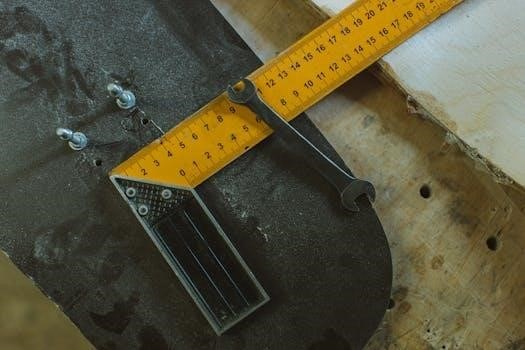Honeywell T6 Thermostat Installation Manual
Welcome to the Honeywell T6 Pro Programmable Thermostat installation guide! This manual provides comprehensive instructions for installing your new thermostat․ Follow each step carefully to ensure proper setup and optimal performance․ The guide includes detailed diagrams and troubleshooting tips for a smooth installation process․
Package Contents
Before beginning the installation of your Honeywell T6 Pro thermostat‚ it is essential to verify that all necessary components are present in the package․ This ensures a smooth and efficient setup process‚ minimizing potential delays or complications․ Carefully unpack the box and compare the contents against the list provided․
The standard package typically includes the T6 Pro thermostat unit itself‚ which serves as the primary control interface․ A UWP (Universal Wall Plate) mounting system is also included‚ which simplifies the installation process and ensures compatibility with various wall types․ Additionally‚ you should find a decorative cover plate‚ offering an aesthetic touch to conceal any existing wall imperfections or mounting hardware․
Screws and anchors are provided for secure mounting of the UWP to the wall․ To power the thermostat‚ two AA batteries are included․ Finally‚ comprehensive thermostat literature‚ including installation instructions and a user guide‚ is included to assist with setup and operation․ Ensure all these items are present before proceeding․
UWP Mounting System Installation
The UWP (Universal Wall Plate) mounting system is a critical component for securely installing your Honeywell T6 thermostat․ Begin by carefully positioning the UWP on the wall at the desired location‚ ensuring it is level for accurate temperature sensing․ Use a pencil to mark the mounting holes through the UWP onto the wall․
Next‚ pre-drill holes at the marked locations․ If installing on drywall‚ use appropriate anchors for added stability․ Secure the UWP to the wall using the provided screws․ Ensure the UWP is firmly attached and does not wobble․
Once the UWP is mounted‚ carefully thread the thermostat wires through the designated opening in the UWP․ This step is crucial for establishing the electrical connections between the thermostat and your HVAC system․ Refer to the wiring diagrams in the manual to ensure correct wire placement․
With the wires properly threaded‚ you can proceed to connect them to the appropriate terminals on the UWP․ Double-check all connections to avoid any wiring errors․ Finally‚ gently push any excess wire back into the wall cavity before attaching the thermostat to the UWP․

Wiring Terminal Designations

Understanding the wiring terminal designations is essential for correctly connecting your Honeywell T6 thermostat to your HVAC system․ Each terminal is labeled with a specific letter or combination of letters that corresponds to a particular function․ Incorrect wiring can lead to system malfunctions or damage․
Common terminal designations include “R” for power‚ “W” for heating‚ “Y” for cooling‚ “G” for fan‚ and “C” for common․ The “R” terminal typically connects to the 24VAC power supply from your HVAC system․ The “W” terminal controls the heating function‚ while the “Y” terminal activates the cooling function․ The “G” terminal operates the fan‚ and the “C” terminal provides a common ground for the thermostat․
For heat pump systems‚ additional terminals such as “O/B” for reversing valve may be present․ The “O/B” terminal determines whether the heat pump provides heating or cooling․ Carefully consult the wiring diagrams in the installation manual to identify the correct terminal designations for your specific HVAC system․
Always double-check your wiring before powering on the thermostat to prevent any electrical issues․
Wiring Conventional Systems (Forced Air and Hydronics)
Wiring your Honeywell T6 thermostat to conventional systems like forced air and hydronic setups requires careful attention to terminal connections․ For forced air systems‚ the basic wiring typically involves connecting the R‚ W‚ Y‚ G‚ and C terminals․ The R terminal connects to the 24VAC power‚ W to the heating system‚ Y to the cooling system‚ G to the fan‚ and C to the common wire․
Hydronic systems‚ which use hot water or steam‚ may have slightly different wiring configurations․ In these systems‚ the W terminal controls the boiler or circulator pump‚ while the other terminals may not be used depending on the specific setup․
When wiring either type of system‚ ensure that the thermostat’s base plate is securely mounted and that all wire connections are tight and properly insulated․ Refer to the wiring diagrams in the installation manual for precise guidance․
It’s important to identify whether your system is single-stage or multi-stage‚ as multi-stage systems require additional wiring for each stage of heating or cooling․ Always disconnect power to the HVAC system before beginning any wiring work to prevent electrical shock․
Setting Slider Tabs
Configuring the slider tabs on your Honeywell T6 thermostat is a crucial step for proper system operation․ These tabs‚ often located on the back or side of the thermostat‚ determine the specific function of certain terminals‚ ensuring compatibility with your HVAC system․ Typically‚ these settings include options for heat pump systems‚ conventional systems‚ and fan control․
For example‚ one slider tab might dictate whether the thermostat controls a heat pump or a standard furnace․ Another tab could configure the fan operation‚ allowing you to choose whether the fan runs only during heating or cooling cycles or can be set to run continuously for better air circulation․
Before making any adjustments‚ consult the wiring diagrams in the T6 installation manual․ Incorrect slider tab settings can lead to improper system behavior or even damage to your HVAC equipment․
Double-check that the slider tabs are firmly in place after setting them to prevent them from shifting during operation․ Verify that the selected settings match your system type and desired fan behavior to optimize comfort and energy efficiency․
Ventilation Systems Wiring
Wiring ventilation systems to your Honeywell T6 thermostat enhances indoor air quality․ Modern homes often incorporate ventilation systems to introduce fresh air and expel stale air‚ reducing pollutants and humidity․ Connecting these systems to the thermostat allows for automated control‚ optimizing energy efficiency and comfort․
The T6 thermostat supports various ventilation configurations‚ including whole-house fans‚ energy recovery ventilators (ERVs)‚ and heat recovery ventilators (HRVs)․ Refer to the thermostat’s wiring diagram and your ventilation system’s manual for specific instructions․
Typically‚ the thermostat connects to the ventilation system’s control board‚ enabling it to activate the fan based on a programmed schedule or indoor air quality parameters․ Ensure the wiring connections are secure and properly insulated to prevent electrical hazards․
Consider using a dedicated ventilation terminal on the thermostat‚ if available‚ to simplify the wiring process․ Correct wiring ensures the ventilation system operates in sync with your heating and cooling‚ providing a balanced and healthy indoor environment․ After wiring‚ test the system to verify proper functionality․
Thermostat Mounting
Proper thermostat mounting is critical for accurate temperature sensing and optimal performance․ Begin by selecting a suitable location on an interior wall‚ away from direct sunlight‚ drafts‚ and heat sources․ Avoid exterior walls‚ kitchens‚ and bathrooms‚ as these areas can experience temperature fluctuations that affect thermostat readings․
The ideal mounting height is approximately five feet above the floor․ Use the UWP mounting system included with the Honeywell T6 thermostat to securely attach the thermostat to the wall․ First‚ level the UWP mounting plate and mark the screw locations․ Drill pilot holes if necessary‚ and then secure the plate to the wall using the provided screws and anchors․
Once the UWP mounting plate is firmly in place‚ carefully align the thermostat with the plate and snap it into position․ Ensure the thermostat is flush against the wall for accurate temperature sensing․ After mounting‚ verify the thermostat display is clear and easily readable․ Proper mounting ensures the thermostat functions reliably and provides accurate temperature control for your home․
System Operation Settings
Configuring the system operation settings on your Honeywell T6 thermostat ensures it functions correctly with your heating and cooling system․ These settings define how the thermostat controls your HVAC equipment to maintain your desired comfort levels․ Access the system operation settings through the thermostat’s menu․
First‚ specify the type of system you have⁚ forced air‚ heat pump‚ or hydronic․ Select the appropriate option to match your system configuration․ Next‚ define the heating and cooling stages․ This setting indicates how many stages of heating and cooling your system utilizes‚ allowing the thermostat to optimize energy usage․
Configure the fan operation settings to determine how the fan operates during heating and cooling cycles․ Choose whether the fan should run continuously‚ cycle with the system‚ or be controlled manually․ Adjust temperature limits to prevent extreme heating or cooling․ Set minimum and maximum temperature thresholds to ensure energy efficiency and protect your system․
Finally‚ enable or disable adaptive intelligent recovery to allow the thermostat to learn your system’s heating and cooling patterns․ This feature optimizes start times to reach your desired temperature efficiently․ Save your settings to activate the new system operation parameters․
Installer Setup (Using the Thermostat)
The installer setup menu on the Honeywell T6 thermostat provides advanced configuration options․ These settings are tailored for HVAC professionals to fine-tune the thermostat for optimal performance․ Access the installer setup menu by pressing and holding specific buttons․ Refer to the installation manual for the exact button combination to enter this mode․
Once in the installer setup‚ you can configure system-specific parameters․ These parameters include cycle rates‚ temperature swings‚ and equipment staging․ Adjust the cycle rates to match your system’s heating and cooling characteristics․ Finer adjustments prevent short cycling and improve comfort․
Modify the temperature swing settings to control the temperature variance around your setpoint․ A smaller swing maintains a more consistent temperature‚ while a larger swing saves energy․ Configure equipment staging to optimize the operation of multi-stage heating and cooling systems․ Proper staging ensures efficient and comfortable climate control․
Calibrate the temperature sensor if needed to match the actual room temperature․ This calibration ensures accurate temperature readings․ Set up custom schedules tailored to the homeowner’s specific needs․ These schedules optimize energy savings․ Save all configured settings to implement the installer-specific setup․
Installer System Test
The Honeywell T6 thermostat includes a system test mode․ This feature allows installers to verify the correct operation of the connected HVAC equipment․ Access the system test mode via the installer setup menu․ Consult the installation manual for the specific steps to initiate the system test․
The system test mode cycles through different heating and cooling stages; This ensures that all components are functioning correctly․ Observe the operation of the furnace‚ air conditioner‚ and fan during each test phase․ Check for proper start-up‚ airflow‚ and temperature changes․
The thermostat displays diagnostic information during the system test․ This information includes error codes and operational status․ Use this data to identify potential issues․ Address any problems before completing the installation․
Verify the proper wiring and connections by observing the system’s response to each test phase․ Confirm that the thermostat is controlling the equipment as expected․ Run the system test multiple times to ensure consistent and reliable operation․ Document all test results for future reference․ Completing the system test ensures a properly installed and functioning HVAC system․
Troubleshooting


Encountering issues during or after the Honeywell T6 thermostat installation is not uncommon․ This troubleshooting guide offers solutions to common problems․ If the thermostat displays a blank screen‚ check the power supply and battery installation․ Ensure the thermostat is properly connected to the power source․ Replace the batteries if they are low or depleted․
If the thermostat is not communicating with the HVAC system‚ verify the wiring connections․ Ensure that all wires are securely connected to the correct terminals․ Refer to the wiring diagrams in the installation manual․ Check for loose or damaged wires․
If the thermostat is displaying incorrect temperature readings‚ calibrate the temperature sensor․ Access the calibration settings through the installer setup menu․ Adjust the temperature offset as needed․ Ensure the thermostat is not located near heat sources or drafts․
If the HVAC system is not responding to thermostat commands‚ verify the system settings․ Check that the thermostat is configured for the correct system type․ Ensure that the heating and cooling modes are properly set․ Reset the thermostat to factory defaults if necessary․
Specifications
The Honeywell T6 Pro thermostat boasts several key specifications essential for efficient home climate control․ It supports a wide range of system types‚ including forced air‚ hydronic‚ and heat pump systems‚ offering versatile compatibility․ The thermostat operates on a 24 VAC power supply‚ ensuring stable and reliable performance․
Its temperature control range spans from 40°F to 90°F (4․5°C to 32°C) in heating mode and 50°F to 99°F (10°C to 37°C) in cooling mode‚ providing precise temperature adjustments․ The temperature accuracy is ±1°F (±0․5°C)‚ maintaining consistent comfort levels․
The T6 Pro features a clear‚ backlit display for easy viewing in various lighting conditions․ It includes programmable scheduling options‚ allowing users to set custom heating and cooling schedules for different days of the week․ The thermostat is compatible with both conventional and heat pump systems‚ offering flexible installation options․
Its dimensions are approximately 4․06″ H x 4․06″ W x 1․06″ D‚ making it a compact and discreet addition to any home․ The T6 Pro also includes adaptive intelligent recovery‚ learning your system’s heating and cooling patterns to optimize energy efficiency․
Optional Cover Plate Installation
The Honeywell T6 Pro thermostat offers an optional cover plate for those who wish to conceal any existing wall marks or create a more finished look․ The cover plate is designed to seamlessly integrate with the thermostat‚ providing a clean and professional appearance․ Before starting‚ ensure you have the necessary hardware‚ typically included with the cover plate․
To install the cover plate‚ first‚ carefully detach the thermostat from the UWP mounting system․ Next‚ align the cover plate with the mounting system‚ ensuring it is centered and covers any blemishes on the wall․ Use the provided screws to securely attach the cover plate to the wall․ Make sure the screws are tightened adequately to prevent any wobbling or instability․
Once the cover plate is firmly in place‚ reattach the thermostat to the UWP mounting system․ Ensure the thermostat clicks into place and is securely fastened․ Verify that the thermostat functions correctly after the cover plate installation․ The cover plate enhances the aesthetic appeal of your thermostat while providing a practical solution for concealing imperfections․ It’s a simple yet effective way to upgrade the overall look of your installation․
